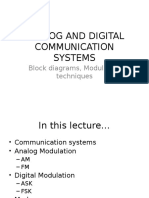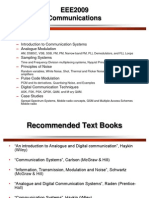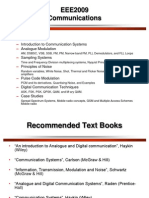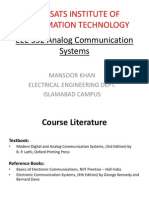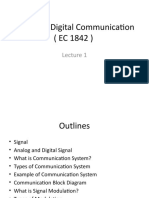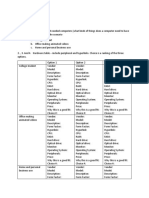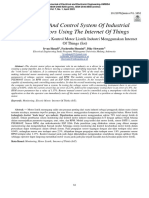0% found this document useful (0 votes)
55 views32 pagesChapter 1 Introduction To Comm
The document discusses key aspects of communication systems, including:
1) The three main parts of any communication system are the message source, transmitter, and receiver. Signals are transmitted over a channel and can be distorted by noise.
2) Signals can be analog, containing continuously varying properties, or digital, represented by discrete values. Common analog modulation techniques include amplitude modulation, frequency modulation, and phase modulation. Digital modulation includes amplitude-shift keying and frequency-shift keying.
3) Communication systems can be either analog, transmitting continuous signals like voice, or digital, converting signals to a binary format before transmission for benefits like error correction and privacy.
Uploaded by
haftamunigusCopyright
© © All Rights Reserved
We take content rights seriously. If you suspect this is your content, claim it here.
Available Formats
Download as PPTX, PDF, TXT or read online on Scribd
0% found this document useful (0 votes)
55 views32 pagesChapter 1 Introduction To Comm
The document discusses key aspects of communication systems, including:
1) The three main parts of any communication system are the message source, transmitter, and receiver. Signals are transmitted over a channel and can be distorted by noise.
2) Signals can be analog, containing continuously varying properties, or digital, represented by discrete values. Common analog modulation techniques include amplitude modulation, frequency modulation, and phase modulation. Digital modulation includes amplitude-shift keying and frequency-shift keying.
3) Communication systems can be either analog, transmitting continuous signals like voice, or digital, converting signals to a binary format before transmission for benefits like error correction and privacy.
Uploaded by
haftamunigusCopyright
© © All Rights Reserved
We take content rights seriously. If you suspect this is your content, claim it here.
Available Formats
Download as PPTX, PDF, TXT or read online on Scribd
/ 32





